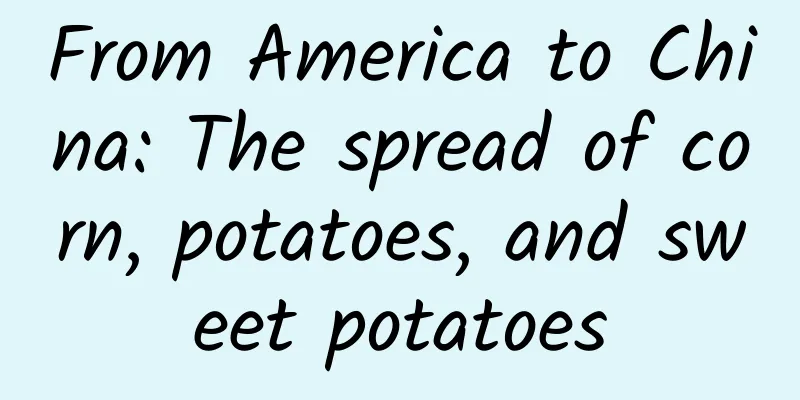From America to China: The spread of corn, potatoes, and sweet potatoes

|
Speaker: Zhang Jian Venue: School of History and Social Sciences, Chongqing Normal University Date: April 2023 Zhang Jian is a second-level professor, doctor of history, and doctoral supervisor at the Department of World History, School of History and Culture, Sichuan University. He is also the vice president of the China Overseas Transportation History Research Association, consultant of the China Agricultural History Society, deputy secretary-general and executive director of the China World Medieval History Research Association, and former deputy secretary-general and executive director of the China World Ancient History Research Association. He mainly studies world history and has written "Research on the Great Geographical Discoveries, 15th-17th Centuries" and "The Spread and Significance of Crops in the New World", and has published more than 200 academic papers. Food crops are the most important crops among crops, and they are related to human survival and reproduction. For China, which has the largest population in the world with more than 1.4 billion people, the feeling of "food is the first necessity of the people" is also profound. Among the crops in America, food crops are also the most important. I have counted in my research that there are more than 60 kinds of agricultural and forestry crops that were domesticated, cultivated, and planted by American Indians in history and are native to America. Among them, those with great influence and wide distribution are roughly divided into eight categories (including food and feed, economic crops, dried fruits, vegetables, fruits, medicinal materials, fragrance, ornamental crops, etc.), with more than 20 kinds. According to their importance, in this lecture, we will only briefly introduce the spread of corn, potatoes, and sweet potatoes among the American food crops. Maize: Two Centuries of Spread Maize is scientifically known as Zea mays, and is an annual herbaceous plant of the Poaceae family. It is also commonly known as corn, corn wheat, etc. Maize has strong adaptability to soil, climate, water and fertilizer, low requirements, fast growth, high yield, low labor and time consumption, easy storage, drought resistance, cold resistance, and barrenness resistance. It has many outstanding advantages, so it has spread throughout the world in about two centuries. The spread of maize, further improvement and breeding of new varieties have greatly solved the problem of food for people on all continents and the problem of feed needed for raising livestock and poultry. On February 15, in Diaoling Town, Linkou County, Mudanjiang City, Heilongjiang Province, farmers used equipment to thresh corn in preparation for spring ploughing. Xinhua News Agency About 7,000 years ago, corn was domesticated and planted in the valleys of the central Mexican plateau. A large stone warehouse storing corn more than 4,000 years ago was discovered in Peru. The Indians also regarded corn as a symbol of life together with humans, and carved it on Mayan monuments and pyramids in Palenque, Chiapas, Mexico. Under the long-term selection and cultivation of the Indians, the main characteristics of each cultivar or variety had basically been formed by the end of the 15th century. Columbus' expedition "discovered" corn after its first voyage to America. Columbus first mentioned it in his diary on October 16, 1492 and called it "Indian grain". He said: "This island (referring to Ferdinand Island-Long Island) is full of lush green... They cultivate and harvest Indian grains and other crops all year round" (Zhang Zhishan compiled: "Columbus's Voyage to America-Historical Documents and Modern Research", Commercial Press, 1994 edition). On November 15, Columbus wrote again: "There (they were in Cuba at this time) there is a piece of land where a crop is planted. The fruit is a bit like wheat. The locals call it Mahiz (the origin of the later Spanish maiz and English maize, meaning corn)." Corn, as a strange crop that Columbus and other Europeans had never seen at the time, aroused great interest among the crew. After tasting it, Columbus and his party praised its taste. When the expedition returned, Columbus brought back corn. Among the gifts he presented to the King and Queen of Spain, there was a bag of golden corn kernels. Corn entered Europe from then on. In 1494, an Italian pamphlet gave a preliminary description of corn. In 1511, botanist Peter Martyr's introduction to corn was widely circulated. In 1532, specimens of European cultivated corn were already in the Italian herbarium. German naturalist Fuchs drew an accurate picture of corn plants in his 1542 "De historia stirpium commentarii insignes" (or "De historia commentarii insignes") and introduced that corn was planted in every courtyard at that time. In his "General History of New Spain" published in 1577, the 16th-century Spanish historian and missionary Sargon described corn in detail. From the middle of the 16th century, corn slowly left the courtyard and became one of the main food and feed crops in southern Europe. In the 17th century, corn was promoted in the Iberian Peninsula and became a grain and fodder crop second only to wheat, and was introduced to the Mediterranean coastal areas of Europe. In the 16th and 17th centuries, corn was called by a variety of names in different parts of Europe, including Spanish millet, Indian millet, Turkish millet, French millet, etc. This also reflects people's understanding of corn and the spread of corn. A picture of a corn plant from Fox's Flora, published in 1542. In the early 16th century, Portuguese slave traders cruising along the west coast of Africa introduced corn to the Congo in West Africa, where it was called "Portuguese millet". Portuguese documents in 1561 mentioned corn from Monomotapa (now western Zambia, northern Zimbabwe, the country of the Karenga people) in the Zambezi River Basin of Africa. Corn then quickly spread to the tropical rainforests of Central Africa. According to the Dutchman Olfert Dapper in the early 17th century, corn was already being grown in large quantities on the Gold Coast of Africa (Ghana). At the same time, corn was also grown in Angola and some other parts of Africa. According to Portuguese records, Portuguese colonists had already grown corn in Zanzibar, East Africa, in 1634. In the early 17th century, corn was introduced to Russia and surrounding areas from the Balkans under Turkish rule. Towards the end of the 18th century, corn spread among the Slavs in Ukraine, the Kuban Lowlands, and Georgia. Over time, corn gradually replaced millet and became one of the staple foods of some poor residents in Russia. However, in the eyes of the middle and upper classes of Russia, corn was still considered a vegetable until the 19th century, and then it was gradually regarded as a grain. In 1601, the Spanish introduced corn to the Mariana Islands in Oceania. At the end of the 17th century, explorer William Dampier discovered that corn was already a staple food for the residents of Timor Island. It can be seen that corn had begun to become popular in Southeast Asia at that time. In 1542, the Portuguese came to Tanegashima in southern Japan, and in 1579 they introduced corn to Nagasaki, Japan. The Japanese wrote corn as "Nanman millet" or "maize". There are many channels for corn to be introduced into China. In simple terms, corn was introduced from West Asia and Central Asia along the Silk Road to Northwest my country (Shaanxi and Gansu); corn was brought to India by the Portuguese, and then introduced to Southwest my country (Yunnan) via Indochina and Myanmar, and later promoted to Sichuan and Guizhou; corn was introduced to the southeast coast of China (Fujian, Zhejiang and Guangdong) by the Portuguese and Chinese merchants across the Indian Ocean and the South China Sea. These three channels introduced corn to my country in the middle of the 16th century. In 1560 (the 39th year of Jiajing in the Ming Dynasty), China had the earliest clear record and morphological description of corn. Zhao Shichun's Pingliang Prefecture Records, Volume 4, Pingliang County Products, states: "Fanmai, also known as Xitianmai, has seedlings and leaves like Shushu but is fatter and shorter, with ears at the end, like rice but not fruit. Fruits are like pagodas, as big as tung nuts, growing between nodes. Flowers hang down like red velvet at the end of the pagodas. They are five or six inches long. Plant in March and harvest in August." Its detailed description can help us clearly identify it as corn, while crops such as "Yumai" recorded in local chronicles before are difficult to identify as corn because of the lack of morphological description. Documents in 1573 (the first year of the Wanli reign of the Ming Dynasty) first explained that corn was introduced from abroad. Tian Yiheng's Liuqing Rizha, Volume 26, "Imperial Wheat" records: "Imperial wheat comes from the Western land, and was formerly known as foreign wheat. Because it was once presented to the emperor, it was named imperial wheat... The flowers bloom at the top and the fruits are set at the nodes. It is really a strange grain. This kind of grain was passed down in my hometown (Hangzhou), and many people grow it." Li Shizhen's Compendium of Materia Medica pointed out: "Corn is grown in the West, and few people grow it." It also said: "A bud grows in the center of the seedling, which is shaped like a brown fish, and white whiskers hang down from the bud. After a long time, the bud opens and the seeds come out, each one in a cluster. The seeds are also as big as rice dumplings, yellow and white. They can be fried and eaten." (Volume 23 "Grain Section·Corn") Although Xu Guangqi's "Nongzheng Quanshu" only mentioned a few words about corn, it is worth noting that the name "corn" was used in "Nongzheng Quanshu": "There is another kind of corn, which is also called jade wheat or corn sorghum, which is probably also obtained from other places." (Volume 25 "Tree Art·Grain Section") Strictly speaking, Xu Guangqi's "Complete Book of Agricultural Administration" was the first to use the word "corn" in the scope of agricultural books. In my research, I found that the word "corn" had already appeared in literary works before "Complete Book of Agricultural Administration". For example, the word "cornmeal" as a food pastry appeared in the Ming Dynasty novel "Jin Ping Mei": "Four plates and four bowls were brought in immediately, and there was a lot of rice on the table, which was too much to eat; and two large plates of cornmeal goose oil steamed cakes were piled up" (Chapter 35). This seems to indicate that the cultivation of corn was still very rare in the Ming Dynasty, and people still regarded cornmeal as a relatively rare food for entertaining guests. In the Qing Dynasty, due to the increase in population, corn was completely spread and popularized. It should be added that the Chinese are not only good at historical thinking, leaving behind a wealth of historical books and historical materials, but also good at figurative thinking, drawing many historical pictures about corn. Li Shizhen's Compendium of Materia Medica drew a simple picture of corn, capturing the characteristics of the corn plant; Wu Qijun's Illustrated Records of Plant Names and Realities (Volume 2, Cereals, Maize) in the Qing Dynasty even drew details of the stems, leaves, male and female inflorescences (ears). The appearance of corn pictures in the Ming and Qing dynasties also indirectly reflected that corn was entering the daily life of the Chinese people. In terms of processing and eating corn, the Chinese have developed a variety of ways to eat it: including boiling, grilling, steaming corn cobs, frying corn kernels to make dishes, grinding corn kernels into flour to make steamed buns, breaking corn kernels and cooking them with rice or millet to make porridge, etc. Corn also has an impact on Chinese language and culture. For example, the popular allegorical saying "a monkey (or bear) breaking corn (or corn) - breaking one and throwing one away" has been formed. Potatoes: From "ghost apple" to "hot potato" Potato (Solanum tuberosum L.), also known as potato, sweet potato, yam egg, etc., is an annual herbaceous plant of the Solanaceae family. For the sake of convenience, I will use the more common name of potato in life below - potato. According to research so far, the history of potato domestication and cultivation can be traced back to 7,000 years ago. The area where humans first cultivated potatoes can be located between Lake Titicaca and Lake Poopó in Bolivia. Potato-shaped pottery has been found in Peru and Bolivia in the 4th century AD. Potato-shaped pottery has also been excavated in ancient tombs from Peru to Chile. The oldest extant color picture of potatoes was drawn by Crusius of France in 1588. Potatoes have many advantages, including low soil requirements, low demand for water and fertilizer, high yield, good nutrition, resistance to war, easy processing and consumption, and the ability to grow in high-altitude and cold areas. Around the end of the 16th century, potatoes gradually spread to all parts of the world. There are different opinions about the initial spread of potatoes. American scholars believe that the Spanish discovered it when they arrived in northern Peru in 1532. Potatoes were introduced to Spain from Peru in 1570. However, British scholars believe that potatoes were introduced to Europe by the Spanish in 1525. Soviet scholars have verified that the Spanish navigator Siza de Leon brought some potato tubers back to Spain from Peru in 1555 and reported to King Charles I how to eat this rare crop. This was also the first time that potatoes appeared in Europe. After potatoes were introduced to Europe, they were initially planted in courtyards for viewing and for collection and research by botanists and pharmacists. The famous German botanist Fuchs drew a color picture of potato plants and fruit tubers in his "Vienna Plant Codex" with reference to cultivated potato crops before 1560. This is probably the earliest potato picture in Europe. Historically, the promotion of potato fruit tubers was slowed down due to their irregular shape, many nodes, dark buds, difficulty in peeling, and poor color. People once suspected that they were poisonous. Of course, we now know that sprouted potatoes and uncooked buds are toxic because they contain solanine; the parts that have turned green due to poor storage and excessive exposure to the sun are also toxic because they contain glycoalkaloids and need to be thrown away or cut off. 400 years ago, people even believed that eating potatoes would cause the spread of leprosy. Therefore, the Burgundy region of France officially announced in 1619 that potatoes were forbidden in the region. The prejudice against potatoes lasted for two centuries in Europe, but the high yield of potatoes and the improvement of people's understanding still gradually promoted potato cultivation. For quite a long time, the names of potatoes in European countries were very confusing, with dozens of names. The confusion of names also reflected the views of various countries at that time on the origin, spread and characteristics of potatoes. This confusion also led to the fact that the roots of potatoes in major European languages today are very different. English, Spanish, Italian, and Portuguese are derived from the common roots of potato, patata, patata, and batata respectively; German, Russian, and Dutch are derived from the common roots of kartofell, картофель, and aardappel respectively; French is the phrase pomme de terre (meaning: apple in the soil). The earliest record of Europeans eating potatoes in large quantities appeared in 1573, when a hospital in Seville regularly bought potatoes for consumption. This shows that potatoes had entered the fields and markets in Spain. According to records, potatoes were cultivated as vegetables in Italy in 1588. Potatoes were introduced to Britain in the second half of the 16th century. Famous pirates such as Drake, Hawkins, and Raleigh were the first to introduce potatoes to Britain. At the latest in 1596, the Englishman Gerrade had planted potatoes in his garden in London. In 1552 and 1553, the "General History of the Indians" and "Annals of Peru" written by Gomara were published in Spain, becoming the earliest Western documents to record and introduce potatoes. French agronomist de Serres introduced potatoes accurately in 1600, and Austrian Clucius made the earliest botanical description of potatoes in 1601, and introduced that potatoes were already planted in most vegetable gardens in Germany at that time. Frequent and fierce wars in Europe during the late Middle Ages and early modern times also greatly stimulated the promotion and popularization of potatoes. In 1641-1642, an anti-British uprising broke out in Ireland. The British invaders brutally suppressed the rebels in Ireland, and the war caused most crops to fail or even fail. However, potatoes survived the hardships underground, allowing the Irish to survive famines and disasters. Ireland also became the first European country to use potatoes as one of the staple foods. From 1697 to 1698, Peter the Great of Russia and his entourage visited Western Europe. After returning home in 1699, he received a bag of potatoes (potato pieces) sent by a Dutch friend in Moscow. Peter the Great ordered them to be distributed to various provinces for cultivation, and potatoes were introduced to Russia from then on. In contrast to the long-term discrimination against potatoes in Western Europe, potatoes were a rare food and were basically only supplied to aristocratic families in Russia throughout the 18th century. Since various types of food poisoning often occurred due to not throwing away sprouted tubers, not digging out the buds, not cutting off the green skin and flesh, or not cooking them thoroughly, some Russians during this period called potatoes "ghost apples" (чёртова яблока), and the vast majority of Russian peasants and serfs did not accept them. Later, with the concurrent famine and plague in Russia in 1765, Catherine II at the time realized the importance of potatoes, and the Tsarist government began to vigorously encourage potato planting. Nicholas I continued to persuade farmers to plant potatoes in the first half of the 19th century, and potatoes were gradually promoted in Russia. It is currently speculated that the Portuguese introduced potatoes to India in the second half of the 16th century. Potatoes were subsequently introduced to Indonesia. According to Western historical records, the Dutch brought potatoes to Nagasaki, Japan in 1601. Recent studies have further revealed that the Dutch brought potatoes to Nagasaki from the port of Jakarta on Java Island in Indonesia (the Japanese called it the port of Jagatara at the time) and introduced them to Japan. Therefore, in the late Middle Ages and early modern times, the Japanese called potatoes Jagatara taro. After sound changes and simplification, it evolved into the Japanese word for "potato" today, Jagaimo, and its pronunciation is still based on that place name (Jagatara). At the end of the 18th century, the Russians introduced potatoes from the north to Hokkaido. Potatoes gradually spread in northeastern Japan and were used for viewing, then as feed, and then as vegetables and food. Potatoes may have been introduced to China via two routes, one north and one south. In the mid-17th century, the Dutch introduced potatoes from Japan to Taiwan. According to the Dutchman John Struys, he saw potato cultivation in Taiwan in 1650 (the seventh year of Shunzhi in the Qing Dynasty). Later, potatoes were introduced from Taiwan to Fujian and Guangdong, so there is still a custom in these areas to call potatoes Dutch potatoes and Java potatoes (see Yang Hongzu, Teng Zongfan, and Yifan: "Potatoes", "Chinese Agricultural Encyclopedia·Crops Volume", Agricultural Press, 1993 edition). Around 1700, Westerners also saw potato cultivation in Dinghai County, Zhoushan Island. At present, the earliest Chinese historical material that accurately records potatoes may be Li Shizhen's "Compendium of Materia Medica" (written in 1578). "Compendium of Materia Medica" Volume 27 "Vegetables 2·Tu Yam" says: "Tu Yam, also known as Tu Lu, Huang Du, and Tu Dou. Tu Yam grows on vines, with leaves like bean leaves. Cuckoos (referring to cuckoos) vomit after eating it, and people cannot eat it." This is the first time that potatoes are mentioned. It also says "Tu Yu grows on vines, like taro. ... People cook it with ash juice and eat it, ... the flesh is white and the skin is yellow, ... it can be steamed and eaten" (ibid.). Later, Xu Guangqi's "Complete Book of Agricultural Administration" (written in 1628) Volume 27 "Tree Art·Gan Bu" also says: "Tu Yam, also known as Tu Dou, also known as Huang Du, grows on vines, with leaves like beans (leaves), roots round like chicken eggs, flesh white and skin yellow, can be cooked with ash juice, and can also be steamed and eaten. Boil taro juice to wash greasy clothes, and they will be as white as jade." Potatoes are mentioned here again. I think the crop fruit that grows in this land, has round roots like chicken eggs, looks like taro, has white flesh and yellow skin, and can be steamed and boiled, is most likely referring to what we call potatoes. From this perspective, potatoes may have been introduced to China in the late Ming Dynasty. In the late Ming Dynasty, Lü Bi's "History of the Palace of Ming Dynasty" recorded the "precious delicacies of the time" that the palace wanted to collect for tasting, including "pine nuts from Liaodong, yellow flowers and golden needles from Jibei, yam and potatoes from the capital, moss and pickled bamboo shoots from the southern capital, hawk's beak bamboo shoots, Polygonatum, and black ginseng from Wudang, hazelnuts, chestnuts, pears, dates, walnuts, Coptis, tea, magnolia sprouts, bracken, and turnips from the northern mountains, which are countless" (Volume 4 "Food and Beverages·First Month", Volume 651 of the Complete Library of the Four Branches of Literature). Potatoes are mentioned again here, and it is clearly stated that they are a delicacy for the nobles to eat. Potatoes are separated from yam and explained that they are produced in the Beijing area. It can be inferred that the potatoes mentioned here should be potatoes. In the initial stage of potato introduction into China, the Chinese, like the Europeans, initially suspected that it was poisonous. In the early Qing Dynasty (around 1680), Kangxi's "Jifu Tongzhi·Products" recorded that "Tuya is also called potato, and the taste of steamed food is like sweet potato", indicating that potatoes had been introduced to Hebei Province from the north before the 1680s. The name of potato was first seen in the "Songxi County Chronicle·Products" of Fujian Province in the 39th year of Kangxi, which also gave a general description of its characteristics: "The vegetable grows on trees and is dug up. It has different shapes, is slightly like a bell, is black and round, and tastes bitter and sweet." Volume 57 "Products·Quanzhou Prefecture" of Kangxi's "Fujian Tongzhi" said that Quanzhou Prefecture "has taro and sweet potato". Taro and potato is probably a transitional name from Tuya to potato. In the Daoguang period, Wu Qijun wrote "Illustrated Records of Plant Names and Realities", and its volume 6 "Vegetables" not only detailed all aspects of Yangyu (potato), but also said that Shanxi "commonly calls it yam egg". Therefore, the Book of Wu recorded for the first time two common aliases of potato - Yang (foreign) taro and yam egg, and drew a full picture of it. This is the first accurate picture of potato in China. Since modern times, potato cultivation has spread throughout China. In modern times, with the progress of production and the improvement of living standards, potatoes are increasingly playing the role of common side dishes, such as braised pork with potatoes, steamed pork with potatoes, fried shredded potatoes, stewed mashed potatoes, etc. Today, various fried and puffed (potato) chips and French fries processed by modern industrial methods have also become popular. In 2008, China's potato planting area was more than 88 million mu, making it the world's largest potato producer and consumer. Since modern times, the Chinese proverb "hot potato" has been popular, which shows its profound impact on Chinese life. Sweet potatoes: a food and feed crop that can be eaten raw or cooked Sweet potato belongs to the Convolvulaceae family, an annual or perennial herbaceous tuberous plant, with the scientific name Ipomoea batatas L., and the English name Sweet potato. It is commonly known as sweet potato, white potato, sweet potato, red potato, etc. The tubers of sweet potato can be eaten cooked or raw, and can also be used as feed, sugar and alcohol production, etc. Its stems, vines and leaves can also be used as feed. It is a relatively important food and multi-purpose crop. A picture of sweet potato drawn by German scholar Erscholz in the mid-to-late 17th century. Sweet potato cultivation originated in Central and South America. In the late 1960s, people excavated sweet potato root remains from caves in the Chilca Canyon in Peru, South America, which were determined to be more than 10,000 years old. In Central America, sweet potatoes were domesticated and cultivated by Indians at least 5,000 years ago. People set the origin center of sweet potatoes between the Yucatan Peninsula in Mexico and the mouth of the Orinoco River in Venezuela. The cultivated varieties of sweet potatoes were first domesticated and cultivated in this area, and were spread to the Caribbean and South America by local Indians 4,500 years ago. By the time of Columbus, many tribes, including the Aztec Indians in the tropical rainforests of the Amazon River Basin and the Orinoco River Basin, the Chibcha people in the Bogota (city) Valley area in Colombia, and the Maya, widely planted sweet potatoes. Around the end of the 15th century, the sweet potato was brought back to Spain and Europe by Columbus and historian GFde Oviedo. But they brought back tubers instead of cultivating them. In 1526, the Spanish introduced the sweet potato from the West Indies to Spain for cultivation and then spread it to European countries. The spread and popularity of the sweet potato in Europe was relatively slow. For a period of time, it was misunderstood like potatoes and was believed to contain substances that were harmful to the human body. This situation also indirectly shows that the first people who were interested in new crops were European pharmacists and botanists, and their motivation was probably more to find new drugs. In the 17th century, the planting area of sweet potatoes in Spain was expanded, but in Europe, due to dietary habits and geographical conditions, the influence of sweet potatoes was limited. There were relatively few documents and pictures about sweet potatoes during this period. In the mid-to-late 16th century, Spanish historian and missionary Sargon visited the Aztec sweet potato fields and wrote detailed information about sweet potatoes in the General History of New Spain (1577): they "have other edible roots, formed like turnips underground, called camotli: these are the local sweet potatoes, which are cooked, eaten raw and fried". In the mid-to-late 17th century, German scholar Elscholz drew a relatively realistic and complete picture of the sweet potato vines, leaves and tubers. In the 16th century, slave ships traveling between America and Africa used sweet potatoes as food for slaves. Sweet potatoes were introduced to the coast of West Africa and gradually spread throughout Africa. Later, sweet potatoes were introduced from the Atlantic Ocean to the Indian Ocean and into India. In the first half of the 16th century, the Spanish brought sweet potatoes to the Southeast Asia - the Malay Archipelago, first to Manila in the Philippines and the Moluccas in Indonesia, and then from this archipelago to various countries on the Asian continent. In 1769, British navigator Captain Cook and his accompanying botanists Boone and Solander discovered that the local indigenous people in Tahiti in the Polynesian Islands planted and ate sweet potatoes. Although sweet potatoes are believed to have originated in the Americas, they had clearly arrived in Tahiti long before any European visit (including the earliest Magellan's crossing of the Pacific Ocean), and were also confirmed to have been brought to New Zealand, where no Europeans had been before. People have discovered ancient relics of sweet potatoes (tuberous roots) on the Cook Islands in that area, which can be traced back to 1000 AD through radiocarbon dating. People believe that sweet potatoes may have been introduced to the central Polynesian Islands in 700 AD. It is speculated that it is likely that the Polynesians sailed to South America and brought back sweet potatoes, and then spread them to Easter Island, Hawaii and New Zealand. Considering that Magellan's fleet crossed the Pacific Ocean and arrived in the Philippines in 1521, it is estimated that sweet potatoes were slowly introduced to the Philippines from America in the middle of the 16th century. They were introduced to the Ryukyu Islands by the Portuguese in the early 17th century. In 1615, the Englishman Richard Cox introduced sweet potatoes to Japan. He wrote in his diary on June 4, 1615: "Today we transplanted this potato to the Nagasaki area." This is the first documented record of the introduction of sweet potatoes to the Japanese mainland. The route and time of the sweet potato's entry into China are not clearly defined. We speculate that the sweet potato was introduced to China roughly by land and sea in the 1570s and 1580s. In the "Yunnan General Records" of the fourth year of the Wanli reign of the Ming Dynasty (1576), there is a record of the planting of "sweet potatoes" in Lin'an, Yao'an, Jingdong, and Shunning (Volume 27 "Products·Vegetables"), and it is placed between yam and Yunnan board potato, but there is no description or shape description. Qi Biaojia (1602-1645) in the late Ming Dynasty wrote in "Yushan Notes·Binpu": "We also got a different kind of sweet potato from overseas. Each one can be planted on two or three acres, and one or two carts of potatoes can be harvested from each acre to replace grains, enough to feed a hundred people." (Xie Guozhen, ed., "Selected Historical Materials on Social Economy in the Ming Dynasty", Volume 1, Fujian People's Publishing House, 1980 edition) Combining these two records, the "sweet potato" recorded in the "Yunnan General Records" is most likely the imported American sweet potato. According to the "Geography·Products" in Volume 14 of the "Dongguan County Chronicles" of the Xuantong Period of the Qing Dynasty, in the eighth year of the Wanli Period of the Ming Dynasty (1580), Chen Yi, a native of Fenggang, Guangdong, sailed to Annan (Vietnam). The local leader treated him with a local product called sweet potato, which tasted sweet. Chen brought it back. Since this product came from the "foreign country" in the eyes of the Ming people, it was named sweet potato. Then, Chen Zhenlong, a native of Changle, Fujian, introduced sweet potato to Fujian. "During the Wanli reign, the people of Fujian also obtained foreign products. ... There is the country of Luzon to the south of the Fujian Sea. ... Because of trade, many people of Fujian trade in Luzon. The country has red potatoes, which cover the wild and stretch across the mountains. ... However, they were reluctant to give them to the Chinese. The Chinese cut off a few vines and took small ones from the Central Plains. Since then, they have been introduced into Fujian for more than ten years." ("Minshu" Volume 150 "Southern Products·Sweet Potatoes") Xu Guangqi's account of the introduction of sweet potatoes is even more interesting: "In recent years, someone has obtained this kind of seed overseas. The overseas people also forbade it from leaving the country. This person took the potato vines, twisted them into a water-drawing rope, and then crossed the sea. Therefore, they divided and transplanted them, and they were roughly spread across Fujian and Guangdong." ("Nongzhengquanshu" Volume 27 "Tree Art·Ganbu") Compared with the speed of spread in other countries before, the spread of sweet potatoes in China was faster and more comprehensive. At the end of the 16th century, there was a famine in Fujian. The governor Jin Xuezeng vigorously promoted the planting of sweet potatoes, which helped the hungry people survive the famine. He Qiaoyuan once said in the "Minshu" written around 1600 that due to the widespread planting of sweet potatoes, in Quanzhou, "a catty is not worth a penny, and two catties can fill you up." Therefore, the elderly, children, and people begging for porridge on the street can all eat it. ("Minshu" Volume 150 "Nanchanzhi·Sweet Potato") Xu Guangqi summarized the "13 wins" (advantages) of sweet potatoes, including high yield and benefit to people, white color and sweet taste, fast reproduction, disaster prevention and hunger relief, can be used as a basket (sacrificial offering), can be used to make wine, can be stored for a long time, can be used as cake bait, can be eaten raw or cooked, does not affect farming, and can avoid locusts ("Nongzhengquanshu" Volume 27 "Tree Art·蓏部"). Sweet potatoes are resistant to waterlogging, drought and barrenness, and are particularly suitable for China's topographical soil and climate conditions and the tastes of the Chinese people. To date, China has become the number one producer and consumer of sweet potatoes. The planting area is maintained at 75 million to 80 million mu all year round, accounting for about 60% of the world's planting area, and the annual output accounts for about 80% of the world's total output. In addition to boiling and steaming sweet potatoes, Chinese people have also developed many ways to eat them, such as roasting sweet potatoes (sweet potatoes), boiling sweet potato porridge, and sweet potato steamed pork, as well as drying, frying, and deep-frying dried sweet potatoes, which are snack foods. In addition, a very popular saying has been born in China: "If an official does not serve the people, he might as well go home and sell sweet potatoes." summary The three major food crops we introduced, corn, potatoes, and sweet potatoes, can be widely spread around the world because they have many advantages such as high yield, fast growth, low requirements for soil, fertilizer and water, strong adaptability to climate, long sowing period, low labor consumption, little impact from pests and diseases, and easy storage and processing. At the same time, corn, potatoes, sweet potatoes, etc. can also be used as feed (including fruits, stems, vines, branches and leaves), which can significantly promote the development of animal husbandry and produce more meat, eggs and milk, which has a lasting impact on improving people's lives. As corn, potatoes, and sweet potatoes become popular around the world, the cultures of various countries have also been greatly affected. All of the above shows the importance of the spread of corn, potatoes, and sweet potatoes in the history of agriculture. |
<<: The first self-developed machine in China! It has achieved a major breakthrough from scratch →
Recommend
BMW's stake in BMW Brilliance increased to 75%, share adjustment to be completed in 2022
On October 11, the BMW Group announced that it wo...
Xiaomi is actually the second largest wearable device company. Who is the first?
According to the latest report from market resear...
E-commerce game design and planning techniques (Part 2)
The era of content-based e-commerce has quietly a...
Seven tips to teach you how to play with self-media!
In recent years, as the earlier batches of person...
App download revenue: Apple takes 85%, while China Mobile only takes 15%
Yesterday, reporters learned from China Mobile tha...
What to do if Xiaohongshu promotion is not effective? Have you mastered these 4 methods?
Internet marketing has a history of more than 20 ...
With a range of over 450km, Qoros 3 EV may be launched in November
Recently, Qoros Auto's senior management anno...
Analyzing the core model of private domain traffic monetization
Private domain traffic is now a hot commodity, an...
Why do you need to extract wisdom teeth even if they don't hurt? The most comprehensive guide on tooth extraction precautions and costs. I recommend saving this guide!
Recently, a topic "A woman's wisdom teet...
In the age of information overload, what else can content marketing do?
This is an age of information overload. Consumers...
Why do some bank card numbers have 16 digits and some have 19 digits?
Do you know what the numbers on your ID card repr...
Only in this way can the iPhone not be monitored
The news that the iPhone can be monitored even aft...
What is the main function of Apple Pay?
After nearly two years of release and various twi...
2 cases to teach you the correct approach to user operations!
Everyone knows about user operation , but most pe...
Unexpectedly, this nut extract can prevent fat accumulation
Compiled by: Gong Zixin Obesity is a significant ...









